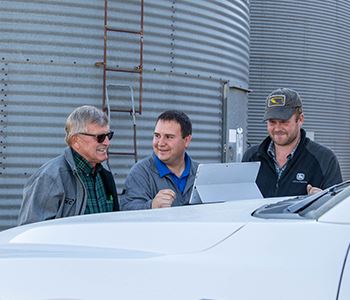Covering Their Bases
Dec 16, 2019

"It was different than anything we’ve done before. We were planting into green stuff this tall,” Justin Regehr says, raising his hand level to his brow as he sat upright in his chair. His father, Royce, noticed neighbors would slowly drive by and study the field, wondering what they were doing. It didn’t take long before the Regehr’s field became coffee shop talk in the small community of Inman.
Roots of the Family Farm
Located two miles south of town, the Regehr’s operation has expanded significantly since its inception as more land became involved with every generational transition. Royce’s grandfather, J.T. Regehr, was one of the first farmers of the land and only grew wheat and oats to use as feed for his cattle. J.T.’s son and Royce’s father, Eldo R. Regehr, later took over and added milo, soybeans, and alfalfa.
Royce partnered with his father in the 1980s and continued to improve the operation as new technology and machinery became available. When Justin joined in 2013, the farm added irrigation systems and implemented more no-till.
Choosing to Cover
Justin recognized the farm had areas that needed improvement, the largest being erosion control. The bare soil fell suspect to Kansas winds and driving rains and had the potential to cause issues during growing seasons. He recalled reading about a possible solution in a No-Till Farmer magazine. That solution was cover crops.
Cover crops are grown between regular grain crop production periods in order to protect and improve the soil. They offer numerous benefits to the soil structure and quality, and aid in weed suppression, erosion control and capturing moisture.
“I was interested in trying cover crops because they hold more moisture, reduce costs and help with erosion control,” Justin says. He first looked to his great-uncle, Dr. David Regehr, a weed science professor at Kansas State University, for expertise.
He then partnered with Chris Thompson, MKC strategic account manager, to develop a plan for
his fields.
“We talked about the advantages and disadvantages to see how it fit into their operation and what they were wanting to do,” Thompson says.
The Regehrs set aside 30 acres of land to conduct an experiment with cover crops led by Thompson and MKC summer intern, Connor Chesky. The study compared standard no-till soybeans to soybeans grown with cover crops that were terminated with different methods and timing. They planted triticale side-by-side in six-acre blocks after corn harvest, at the same time they were planting wheat.
“It was a busy time to try it, and I talked to Chris almost every day, or sometimes twice a day during the experiment,” Justin says.
Prior to planting, Royce and Justin both expressed doubts and fears about trying cover crops in their fields.
“I was really skeptical if it would work, but it did,” Royce says. “The soil won’t blow this winter, that’s
for sure.”
They purposely planted their experiment in a secluded section of the field in an attempt to avoid the public eye.
“I tried the cover crop down on Arrowhead Road because there is very little traffic,” Justin says.
Despite the remote location, neighbors became curious about the experiment and would pull over to ask questions.
The Regehrs discovered their operation could save costs and improve the soil by planting cover crops between growing seasons.
“We had a standard, and I was seeing what I could cut out from growing cover crops,” Justin says. “I cut out a couple of herbicide passes, but had the added cost of triticale seed, drilling, and 30 pounds of nitrogen for increased biomass. I came out with all the benefits of the cover crops, and even a little better profit-wise, which is ultimately what I wanted to see.”
The Regehrs saved about $9 per acre on soybeans planted into standing triticale, compared to no-till soybeans without cover.
In addition to saving costs, the cover crop provided solutions to other issues the Regehrs faced.
“We could see a visual difference between the no-till and cover crops with erosion this spring,” Thompson says. “Dirt had washed up to the corn stalk, but we didn’t see that in the cover.”
Justin says they will continue to move forward with cover crops on a bigger scale in the future and credits his strategic account manager, Thompson, for pushing him to a more efficient farming practice.
“Production agriculture is about seeing how you can do things more efficiently,” Thompson says. “If it fits into your operation, cover crops allow you to do something beneficial to your fields, where otherwise it would be wasted time of the year.”